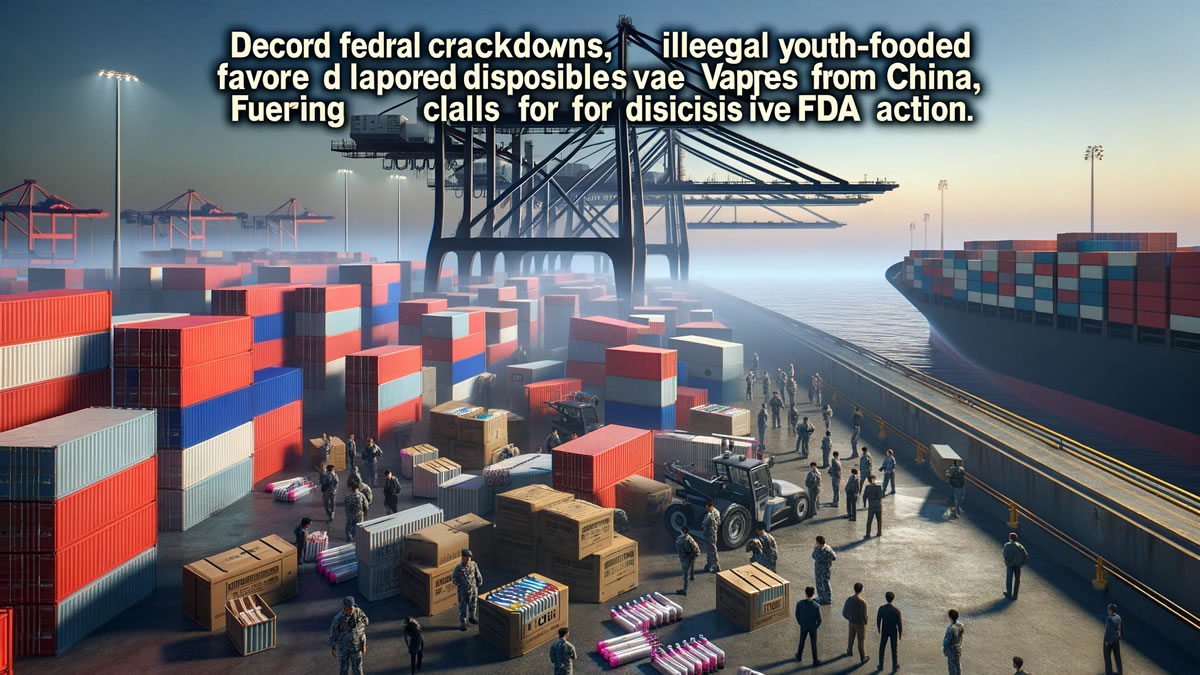Surge in Unauthorized Vape Imports Highlights FDA Enforcement Challenges
Thousands of illegal flavored vaping products continue entering the US from China despite federal efforts to halt unauthorized imports, reveals government data. This massive influx underscores difficulties regulating America's chaotic $7 billion vaping market.
As a public health researcher, I analyze complex policy issues around tobacco and nicotine. This uncontrolled flow of potentially youth-enticing disposable vapes represents a key obstacle to curbing underage usage rates. But current enforcement methods are struggling to stem the tide.

Seizures Rise But Can't Keep Pace With Flood of Imports
Per FDA data, officials detained a record 148 shipments of illegal vaping products in November 2022 - nearly all fruity or sweet flavored disposables from China. This more than doubled seizures from 2021.
Yet an estimated 11,500 unique vaping SKUs now sell stateside, up 27% from June. Disposables generated $3.2 billion in 2022 sales, proving wildly popular despite FDA prohibition.
Authorities are physically unable to intercept more than a small fraction of incoming vape packages given resource constraints. Smugglers also mislabel shipments to avoid detection. For example, packages containing $400,000 worth of banned disposables were disguised as shoes and toys when seized at LAX.
This enormous supply of unauthorized disposables fuels surging teen vaping rates that harm public health. Closing regulatory loopholes enabling easy youth access is key. But the influx shows steep challenges facing under-resourced FDA enforcement.
Manufacturers Nimbly Dodge Bans Through Product Proliferation
When the FDA prohibits specific disposable brands or products, manufacturers subtly repackage prohibited items and relaunch under new names.
There are now over 11,000 vaping products on US shelves - a 27% jump in 6 months. Teens then rapidly switch to these reconfigured "copycat" versions.
Anti-vaping curriculum creators report constantly updating educational materials to match the cascade of new brands and trends. This disposable vape "whack-a-mole" stymies enforcement and prevention efforts alike.
While the FDA unintentionally fuels this cycle by banning specific products reactively, it lacks resources to evaluate entire categories or manufacturing practices proactively.
Over 11,000 Vapes Now For Sale, But Only a Handful Are Legal
The FDA has so far authorized just a tiny fraction of vaping products submitted for review by major companies like Juul. It aims to complete outstanding applications soon but admits delays will persist into 2023.
This leaves over 11,000 vaping SKUs illegally on shelves, as their manufacturers haven't sought FDA approval at all. Yet the agency can't realistically force their rapid removal nor evaluate so many individual products effectively.
The few tobacco-flavored vapes cleared by the FDA see dismal 2.4% market share. Consumers strongly prefer the unauthorized but far more appealing fruity and dessert options - including the 2 million teens vaping illegally.
But endless case-by-case evaluations make the current framework unworkable given limited FDA resources and the deluge of unauthorized products. More effective solutions are urgently needed.
Class-Based Assessments Could Streamline Enforcement
One alternative might involve category-based decisions around safer vape manufacturing processes and youth-protecting design features.
For example, the FDA could prohibit all flavored disposable vapes shown to widely appeal to youth. This class-driven approach could accelerate enforcement.
Small companies first advocated this idea, lacking resources for costly one-off approvals. But anti-teen vaping groups now also endorse streamlined bans of entire youth-focused vape varieties.
Class-based assessments would enable swifter removal of products like fruity disposables fueling the underage vaping crisis. However, impacting adult access would require careful balancing.
Conclusion: Closing Loopholes Key to Curbing Youth Vaping
In summary, the runaway influx of illegal e-cigarettes exposes real limitations in America's product-by-product vaping regulations.
As disposables seduce millions of teens into nicotine addiction, the FDA struggles to keep pace. While import seizures have increased, thousands more unauthorized vapes enter the US unimpeded daily.
Clever manufacturers effortlessly bypass bans on specific items through iterative redesigns under new names. But this "whack-a-mole" cycle has proven ineffective to date.
To achieve meaningful change, the FDA may need to rethink its entire regulatory framework. Public health demands expedient enforcement focused squarely on closing loopholes that drive youth vaping.
